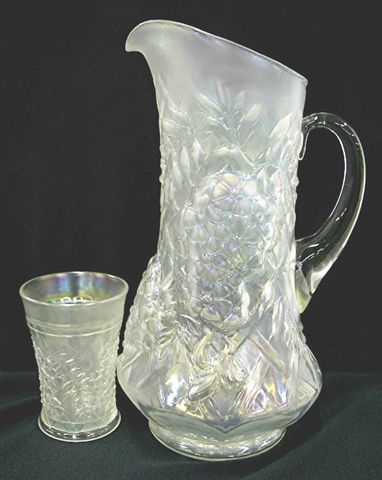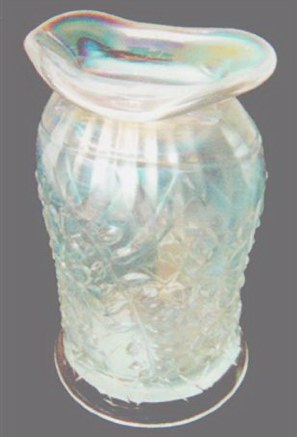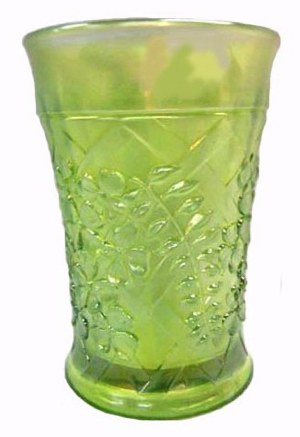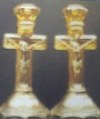Carnival Glass 101 | home Quick Reference to Carnival Glass Patterns on This Site
Northwood Water Sets - Part 2
NORTHWOOD WATER SETS - Part 2
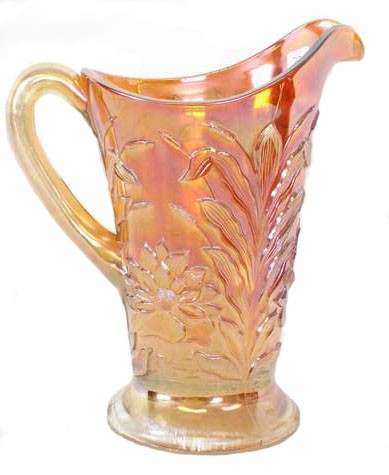
Northwood WATERLILY & CATTAIL Water Pitcher
WATERLILY & CATTAILS: Fenton was the first to market this design in iridized form in 1908, with water sets, berry sets, table sets, a variety of bowls and novelty shapes created for public appeal. *Their pitchers have a bulbous base with a slight basketweave design around the bottom. The tumblers also display this same basketweave pattern at the base.*
Northwood's version of the water set lacks the basketweave design, but they were quick to follow suit with much the same design as that of Fenton. By 1909 their water sets were in iridized production, but it was a short run. The Northwood trademark is found on both pitcher and tumbler. Marigold is the usual color, with pitchers being very scarce. Tumblers turn up in fair numbers. A single cobalt blue pitcher is known, with seven or eight blue tumblers known. A name and date is found etched into the top band of some blue tumblers, along with the date 1909.
WISTERIA: Tumblers to match these rare tankards are quite tall at 4 ¾”. Design similarities with Northwood's Grape Arbor are evident. Wisteria flowers replace grapes, but the main difference is in availability. Wisteria water sets are extremely rare, dating from the 1912-1914 era. The tankard water pitcher is mould-blown, having a separately applied handle. They are nearly non-existent, with white and ice blue, the known colors. Some damage is a factor in most known examples.
Tumblers are extremely rare. Ice blue examples outnumber white, ice green and the few reported lime green tumblers.
A green vase made from the tankard mould sold in 1991 at an antique auction in Ohio, just across the river from Wheeling, West Virginia. It is a dark green, and the only item in Wisteria pattern in a non-pastel color.
WISTERIA Bank - white: is likely the only such whimsey of its kind. We viewed it some years ago in a room display while attending the HOACGA Convention. The top is pinched in and slotted to admit the coins, (provided you are brave enough to drop coins into it?). The piece was fashioned from the tumbler, of course.
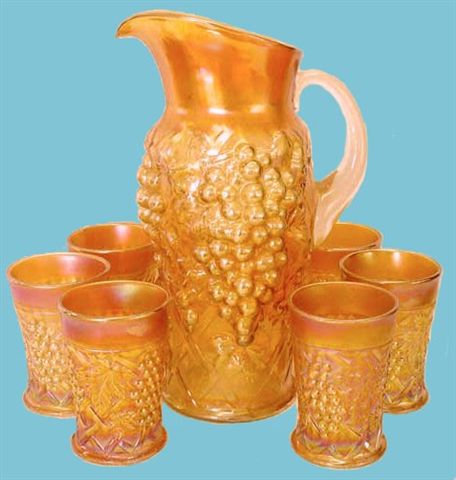 |
|
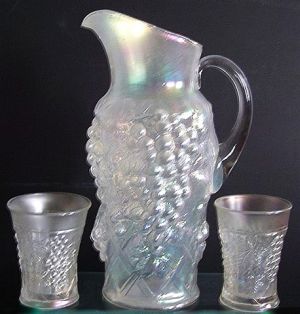 |
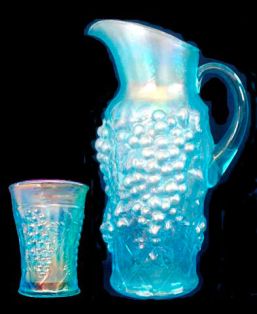 |
GRAPE ARBOR in Ice Blue
|
|
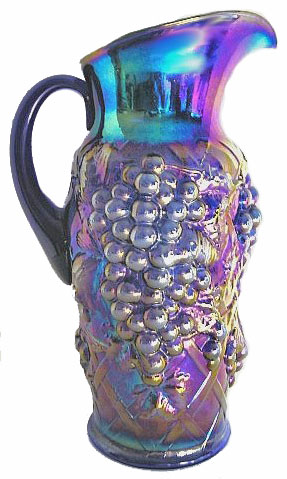 |
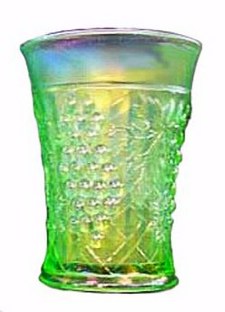 |
Cobalt Blue GRAPE ARBOR
|
GRAPE ARBOR Tumbler in Lime Green
|
GRAPE ARBOR: The direct antitheses of Wisteria in terms of rarity, this pattern presents itself with some degree of frequency. Marigold and amethyst do not present much difficulty if you decide to purchase an example of the pattern. Cobalt blue, white, ice blue and lime green will require a bit more effort to locate, along with more “settlement money”. Additional tumbler colors of lavender, aqua, and pearlized custard create additional challenges for the tumbler collectors!
A hat shape formed from the tumbler is known in marigold, cobalt blue, white and ice green.
Dugan/Diamond Glass Co. produced their own version of the Grape Arbor pattern, in the form of a large, footed fruit bowl having Feather Scroll (inverted Fan & Feather) exterior design.
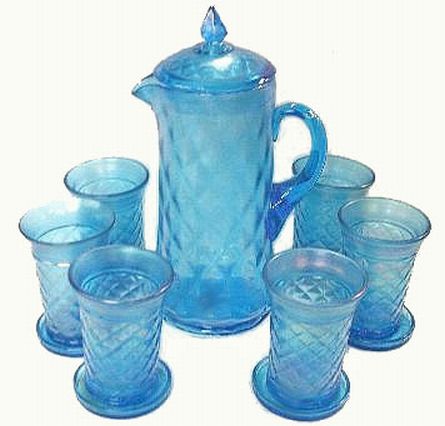 |
|
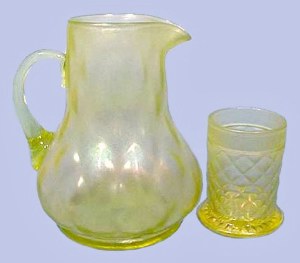 |
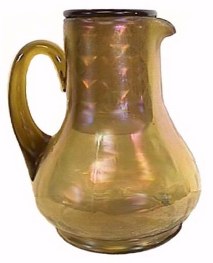 |
TOPAZ Yellow CONCAVE DIAMONDS Guest Set
|
CONCAVE DIAMONDS Guest Set in Russet Color
|
CONCAVE DIAMONDS: Strictly speaking, this pattern lies in the stretch glass category, but much as candlesticks in stretch glass are embraced by carnival glass collectors, Concave Diamonds is also eagerly sought after. Called “satin sheen” when Northwood introduced the line in 1917, it was made in a variety of shape and colors, with pastel shades dominating.
The covered tankard water sets consist of the nearly 12” tankard, along with 6 matching tumblers and coasters. Topaz yellow is a listed color, but the Venetian Blue (called Celeste by carnival glass collectors) sets, scarce as they are, seem to turn up most often. Russet tumblers are known, but as yet, no tankards have turned up. The color Russet was introduced around 1920. Perhaps the need for a complete set had run its gamut during the previous 3 years?
GUEST SET or Tumble Up: Consisting of a small bulbous pitcher, 6 ½” tall, with separately applied handle and a 3 ½” tumbler, these were filled with water and placed in guest bedrooms early in the 1900s. The Tumbler has an oversized marie (collar base), allowing it to be inverted and placed over the neck of the pitcher, forming a cover. In addition to the sets we display here, other sets are known in an iridized opaque blue, which Northwood called Jade Blue.
Dean & Diane Fry ------10/07
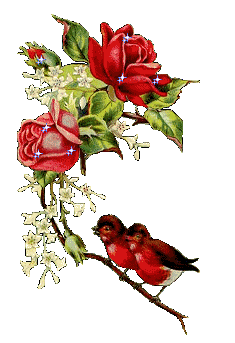 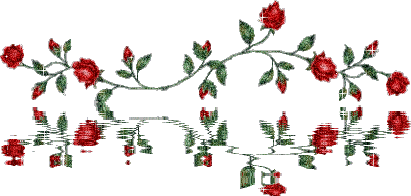  |
|
My son, if you receive my words, and treasure my commands within you, so that you incline your ear to wisdom, and apply your heart to understanding; yes, if you cry out for discernment, and lift up your voice for understanding, if you seek her as silver, and search for her as for hidden treasures; then you will understand the fear of the LORD, and find the knowledge of God. For the LORD gives wisdom; from His mouth come knowledge and understanding…
When wisdom enters your heart, and knowledge is pleasant to your soul, discretion will preserve you; understanding will keep you, to deliver you from the way of evil, from the man who speaks perverse things, from those who leave the paths of uprightness to walk in the ways of darkness; who rejoice in doing evil, and delight in the perversity of the wicked; whose ways are crooked, and who are devious in their paths; to deliver you from the immoral woman, from the seductress who flatters with her words, and who forsakes the companion of her youth, and forgets the covenant of her God…..
So you may walk in the way of goodness, and keep to the paths of righteousness. For the upright will dwell in the land, and the blameless will remain in it; but the wicked will be cut off from the earth, and the unfaithful will be uprooted from it.
~~~~~~ Proverbs 2
 To live wisely, we must seek the LORD
for wisdom and understanding!
|
|
   |
Should you care to contact the Frys, their email address is:
Search Carnival Glass 101
back to Carnival Glass 101
Our other sites you may enjoy:
Everything you EVER wanted to know about Indiana Glass
Great Reference for Newer Carnival Glass.
Complete Glassware Catalogs Available to Download
Questions? Comments? Suggestions? Broken Links? Corrections?
Your Friendly Webmaster is here to help!
